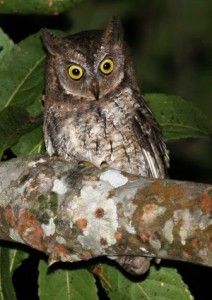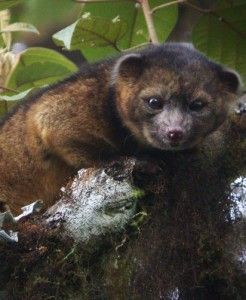A Recap of Our Five Favorite New Species of 2013
An owl, a cat, a dolphin, and of course the olinguito, are among this year’s biggest new species finds
/https://tf-cmsv2-smithsonianmag-media.s3.amazonaws.com/filer/0d/bb/0dbb9bf4-e866-479f-b873-3c01febe9543/tapir.jpg)
New species of insects, fungi, spiders, plankton, plants and even small mammals and reptiles are pretty commonplace. If you have enough expertise and spend enough time in the field, you are almost certainly guaranteed to uncover a new species, even if you're searching in an urban center or an already well-explored country.
Finding a larger animal--a new bird or carnivore, for example--is a much rarer event. But such discoveries do happen, especially as genetic studies are drawing a much finer line between science's traditional definition of what is and is not a species. Sometimes those new species turn out to be right below our noses, in museum collections or long-ignored field anecdotes.
Whether discovered using genetic sequencing or traditional field sleuthing, here are five of the most sensational species reveals of the year:

Otus jolandae, Indonesia's new owl that cries 'pook'
In 2003, two different researchers were exploring Lombak, an island in Indonesia, and both coincidentally picked up on the cry of an unfamiliar owl species.
Locals were well aware of the little owl, whose native name translated as "pook." The owl's distinct cry helped the researchers gather more information; they used recordings of its call to attract other owls and photograph them. The birds turned out to have very different feather patterns than similar owls on nearby islands, and locals living on other islands did not recognize the Lombak species' distinct call, either.
In February, they finally had enough evidence to declare the owl a unique species. One of the researchers named it after his wife, Jolanda.

Bassaricyon neblina, the raccoon-like mammal that evaded detection for a century
Time and time again, scientists inadvertently missed out on identifying this species of small carnivorous mammal.
Colloquially referred to as the olinguito, it looks a bit like an elongated teddy bear with a button nose and lives in the mountainous rainforest in Colombia and Ecuador. But humans had ample contact with it; museum specimens abounded, researchers had seen it in the wild and it had even been kept in captivity at a few zoos in the U.S. And yet, no one noticed that it was a new species, instead grouping it with other raccoon relatives, the olingos.
A team of Smithsonian researchers finally sorted the case of mistaken identity out, however, after they noticed discrepancies between museum specimens. Then, they headed down to South America where they identified and studied the animal in the field. It turns out the olinguito is so wide-ranging that it is actually composed of four sub-species.
The animals were officially declared unique in August, making them the first new carnivore in the Americas to be added to the species list in 35 years.

Humpback dolphins, the species that jumped from two to four
It's not every day that newly discovered members of one of the most popular and beloved of animals, the dolphin, splashes into the headlines. By carrying out some genetic sleuthing, researchers doubled the species count of humpback dolphins, confirming that what was two species is actually four.
What likely started as one species of dolphin eventually diverged into four related but genetically distinct animals, whose divergence was driven by vast distance. The animals look quite similar but their mitochondrial DNA is different enough to warrant unique places on the tree of life.
The newest species, which lives in waters off of Australia, is already inspiring local pride and enthusiasm for protecting it. The country has expressed interest in writing legislation specifically for protecting its new dolphin (which still awaits a scientific name), and the hope is that other countries can likewise design their own management frameworks to protect their own special animals.

Leopardus guttulus, Brazil's new house kitty-sized wild feline
In another win for the geneticists, researchers found that L. tigrinus--which also answers to the names tigrina, oncilla and little spotted cat--is actually two species occupying different parts of the jungle.
The team looked at genetic data from the cats and found that it has been many, many years since they mingled--so many, in fact, that they have diverged enough genetically to call for distinct species labels.
In addition, the new southerly species has been getting friendly with Geoffroy’s cat, another spotted feline friend. Whether or not those hybridizations result in a new species, however, will be the work of future scientists.
Tapirus kabomani, the mammal the locals knew all about
For more than a century, local people living in the Brazilian and Colombian Amazon have spoken about the "little black tapir," a type of large jungle herbivore distinct from its larger relatives. Scientists, however, ignored them. Until, that is, one research came across a strange-looking tapir skull and followed his hunch that something was amiss.
When he visited the jungle, he employed the locals to collect more specimens, and listed to their stories about the smaller tapir they regularly hunted. Photos, videos and genetic evidence published recently confirmed they were right all along, and for the first time since 1865, a new species of tapir was declared. Although the new tapir appears dwarf-like next to its larger relatives found in South American and Asia, it is quite an exciting holiday gift for biologists: it now counts as one of the largest mammals in South America.
/https://tf-cmsv2-smithsonianmag-media.s3.amazonaws.com/accounts/headshot/Rachel-Nuwer-240.jpg)
/https://tf-cmsv2-smithsonianmag-media.s3.amazonaws.com/accounts/headshot/Rachel-Nuwer-240.jpg)